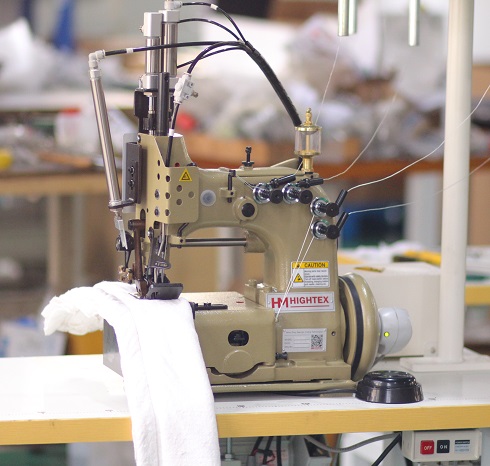Gotextile sewn seams are a critical part of your design when using geotextiles for strength applications.
Geotextile sewing is used as a means of eliminating the expense and time required to make geotextile seam overlaps. Normally a sewn seam will require only a few inches of fabric from each roll, compared to an overlap which may use two to three feet of material. Both woven and non-woven geotextiles can benefit from using sewn seams.
There are three seam types commonly used for geotextiles, the flat seam, the "J" Seam, and the butterfly seam. Each of these seam types can be sewn with varying threads, stitches per inch, or lines of stitching. The easiest seam to produce is the flat seam. The flat seam is often used for lower strength applications, and for joining textiles where strength is not a factor (joining non-woven geotextile for geomembrane protection for example). Flat seams are also the most commonly used seam for non-woven geotextiles.
The "J" seam is a high-strength seam that is ideally suited to woven geotextiles. The "J" seam provides the highest geotextile sewn seam strengths. Butterfly seams are used for very heavy geotextiles where the "J" seam fold is not practical. A butterfly seam provides strengths similar to a "J" seam.
Different sewing machines have the ability to sew multiple stitch lines at the same time. Most factory sewing equipment can sew two stitch lines at a time, and three stitch lines are available on certain types of factory sewing equipment. Field sewing equipment typically sews only one stitch line, and often two passes are required to join high strength materials.
The stitch count is the measure of the number of stitches per inch along the stitch line. In order to meet the strength requirements of the material there must be enough stitches, of strong enough thread, to carry the load across the seam. Typical stitch counts are 3 to 7 stitches per inch.
There are two commonly used stitch types for geotextiles. A simple chain stitch, and a modified 401 lock stitch. The simple chain stitch is sometimes used for lightweight fabrics, and is sometimes mistakenly used in the field (bag closing sewing machines produce a chain stitch). A simple chain stitch should not be used for strength applications as it is prone to unraveling. The modified 401 lock stitch is special stitch that resists unraveling. If an individual thread is broken the seam will not come apart. A 401 lock stitch is easily recognizable by looking at the bottom of the seam. A chain stitch has two lines of thread between stitch holes, a 401 stitch has three threads between stitch holes.
The last factor to look at is the thread itself. There are an extraordinary number of kinds of thread on the market. Most sewing is done with light weight threads for economy, however stronger geotextiles will require threads that have sufficient strength to be able to carry the seam loads. A simple calculation of the number of threads per inch, times the thread single end strength, should result in a value very close to the wide width tensile strength of the geotextile being sewn (ex. 5 stitches/in x 30 lbs/end = 150 lbs/inch width, which would be suitable for LP 200 fabrics). As a rule of thumb we calculate the required thread strength on only one of the two stitch lines in a seam.
Lightweight threads generally consist of a polyester core wrapped in an outer cotton cover (for easy sewing). High strength threads are made from polyester, nylon, and in very high strength applications, Kevlar (which is a trade name for a high strength nylon thread).Seam efficiency is defined as the strength of the seam divided by the original strength of the fabric. If the seam has a strength of 100 lbs, and the original fabric strength was 120 lbs then the seam efficiency is 100/120 or 83%. There are two common ways to test seam efficiency, the grab tensile test method, and the wide width test method. Seam efficiencies measured with the grab tensile test (ASTM D4632-87) tend to give higher results than the wide width test (ASTM D4595-86).
Seam efficiencies for woven geotextiles, on properly adjusted equipment, using the correct threads, are typically 90% as measured by the grab tensile test, or 60% when measured by wide width tensile strength equipment. In high strength fabrics the seam efficiency is dependant on the fabric design. Please contact your representative for high strength fabric design strengths. When designing the engineer should use the wide width tensile seam efficiency of about 50%. Caution should be taken that a grab tensile test result and a wide width test result are not confused.

Request for more information | 
